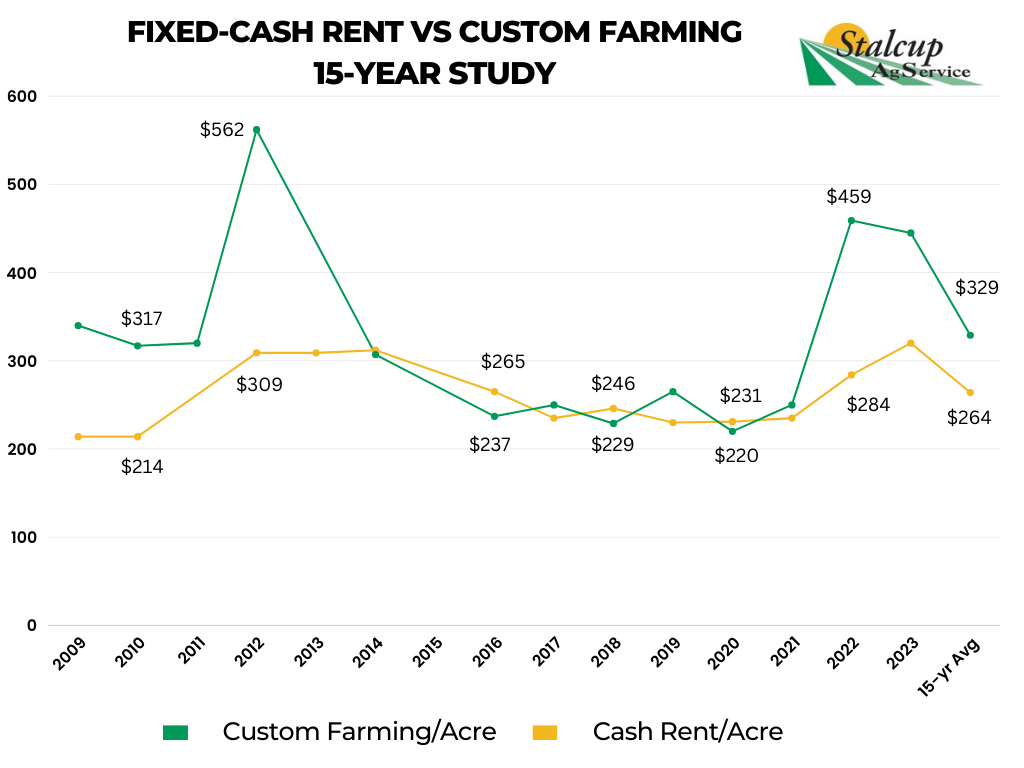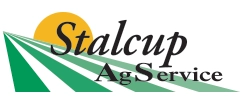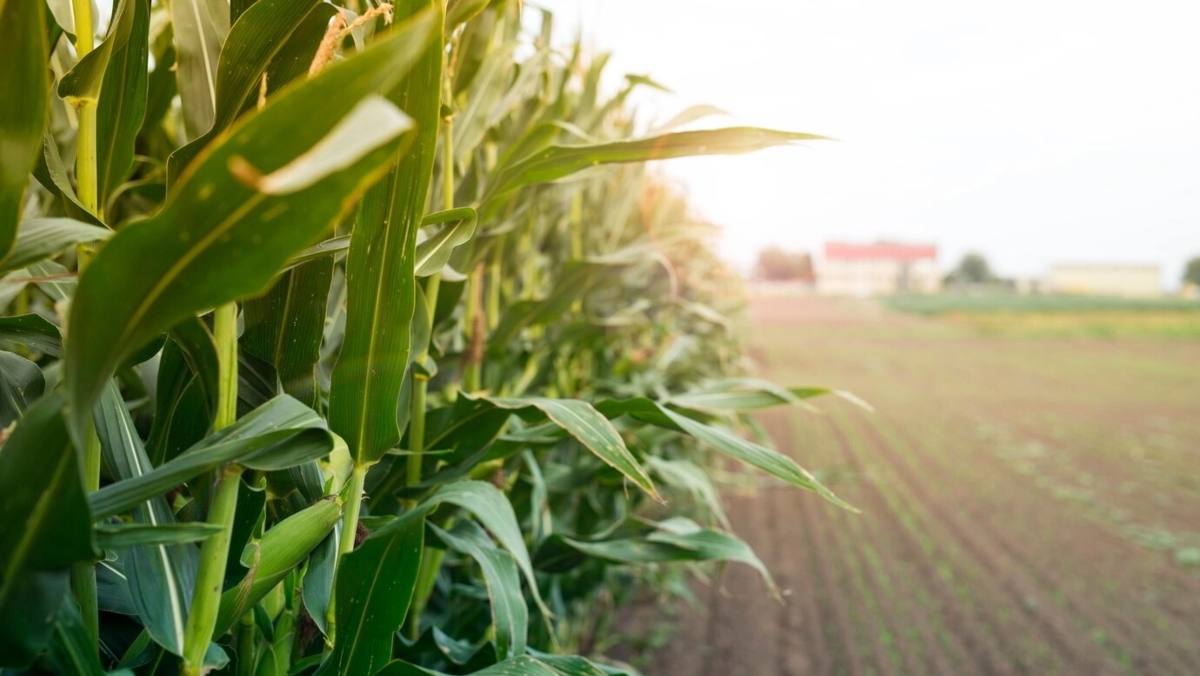Landowners have several options when considering what to do with their farmland. Fixed-cash rent, flexible cash rent, crop share, and custom farming are the main types. The fixed-cash rent and custom farming are complete opposites from an owner involvement standpoint, but they are also the two most popular choices among our clients.
Flexible rent and crop share leases are harder to compare because they can be arranged in a variety of ways depending on the owner’s goals and the quality of the farm, so the results vary widely depending on the details.
In this article, we compare fixed-cash rent with custom farming. First, we should define the two options:
Fixed-Cash Rent
Fixed-cash rent is a set dollar amount agreed to between the landowner and the farm tenant for conditional farm use of the land depending on the terms of the lease. The rental rate is typically renegotiated every year.
The crop is owned 100% by the farm operator along with any USDA farm program payments and federal crop insurance. Lease terms typically include things like payment dates, fertilizer and lime requirements, soil sampling, and records to be shared with the owner.
The farm operator makes all the decisions on farming practices within the parameters of the lease terms.
Cash Rent Advantages
Why the popularity of cash rent? It’s simple to calculate.
- Simple to understand
- Lower risk
- Scheduled payment(s)
- Considered “passive income” for tax purposes
Cash Rent Disadvantages
- No upside in good years
- Lower income than other lease methods
- Less control of operations and purchasing
Custom Farming
Custom Farming gives the owner full control of how their land is farmed. This method is not a lease, but an agreement with a farm operator.
The crop is owned 100% by the landowner, so any USDA farm program payments stay with the owner. The owner is eligible to buy subsidized federal crop insurance the same as any other farmer.
Owners pay all the crop expenses including custom farming rates to a local farm operator who completes the field operations. In the case of our clients, the farm manager directs all field operations with the farm operators, purchases all farm inputs, and markets the grain on behalf of the owner/client.
Our landowner clients can have as much or as little input in farming practices, grain marketing, and any other decisions as they want. Many of our clients want more control over things like soil conservation, fertility, weed control, production records, and many other aspects.
Custom Farming Advantages
- Control over farming operations, such as minimum or no-till
- Control of input purchases
- Tax planning possibilities
- Higher income potential
Custom Farming Disadvantages
- Start-up costs
- Less predictable distributions
- Considered “earned income” for tax purposes
- Higher risk
Which is Better?
Every farm is unique and so is every landowner’s situation, so it depends on the people involved and their goals.
We are often asked which method provides the most economic return, which can vary from year to year and from farm to farm. We compare lease types every year in a variety of ways, looking at past performances and projecting ahead to next year. It’s an important way for farm managers to analyze cash rental rates for the upcoming year.
Generally, we find custom farming will generate the highest net income for landowners, especially on high quality land. But there is somewhat more variability year to year.
Cash Rent vs Custom Farming 15-Year Study

We took a deeper look into the long-term deviation between cash rent and custom farming with a 15-year internal study of 30 managed farms (half custom farmed, and half fixed-cash rent). We carefully selected medium to high quality farms throughout our territory.
We recorded each farm’s net profit per acre including all expenses for the past 15 years. The chart above summarizes the results.
As you can see, custom farming shows a 22% higher net return compared to a fixed cash rent over the 15 years.
However, cash rent yielded similar or higher profits at times. It comes down to the cycle of farm incomes, we generally see a few good years followed by a few bad years. When grain prices are trending lower for an extended period, cash rents tend to be very competitive to custom farming.
On the flip side, custom farming is best during periods of sustained rising grain prices.
Cash rents tend to lag during shifts in farm profitability cycles, so they tend to be too high or too low by the end of the season. The challenge is rental rates are typically set for the next year around the termination deadline of September 1st in Iowa.
On average, September is a poor time in the grain markets because it’s just before harvest when new crop bushels become available. It’s a time of great uncertainty for farmers looking ahead to the next year while still not knowing how the current year will turn out. This combination often puts landowners at a disadvantage negotiating rents.
Study Takeaway
One of the biggest takeaways from this 15-year study is the top end potential of custom farming. On one hand, there are years when cash rent provides a slightly better return than custom farming, but the good years more than make up the difference on average.
For example, in 2011 to 2013 and 2021 to 2023, we saw a 36% higher net income from custom farming compared to our competitive cash rents on average. However, in 2014 to 2019, the two options were essentially dead even.
Why is custom farming more profitable?
Custom farming is more profitable over a long period of time because, from an economic point of view, it must be. If farmers cash rented ground at break-even prices for a long period of time, they would eventually all be bankrupt. Profits are needed to put food on the table and provide a reasonable standard of living for the farm operator.
They must also replace older, worn out equipment from time to time. The person willing to take the risk of planting the crop should also be the one reaping the reward when good yields and/or prices produce a profit.
Despite the financial advantages, custom farming is not for every landowner. The biggest challenge is getting started during the first year with the capital needed to purchase the crop inputs like seed and fertilizer.
The cost to grow corn and soybeans is well above average in 2024. Corn expenses totaled around $600 per acre, and soybeans were about $450 per acre. Not all those expenses need to be paid before harvest, around a third of that can be paid with crop income from the fall harvest.
Generally, you can figure it takes about a year of cash rent income to get started custom farming. There are financing options available to get started if that’s required.
Typically, once a custom farming operation is up and running after the first year, the new farm account is self-sustaining, so no additional capital is needed from the owner.
Another concern landowners may have with switching to custom farming is the risk of major crop loss and falling grain prices. These risk factors are very real and will impact custom farming profitability. However, much of this risk is mitigated through Federal Crop Insurance and USDA farm programs.
I would argue landowners have the risk of lost opportunity in a fixed cash rent, especially when rental rates are established during times of low grain prices.
From the farm operator’s perspective, custom farming is a safe way to spread out equipment costs. There is no crop loss or grain market risk to the custom farm operator. The fixed returns are especially helpful to young and beginning farmers.
Some well-established farmers that own most of their land are not interested in custom farming because it takes away time for them to farm their own ground. When grain prices are up, profits to the custom farmer are much less than under a fixed-cash rent, but that’s the tradeoff for less risk.
We find most growing farm operations already have the equipment and labor needed to add custom acres into their current operation. These farmers are eager to add acres and a guaranteed cash flow.
What method is best for you? Let’s talk about it.
Partner with Stalcup
Learn more about our custom farming services or contact us today to talk about whether you would benefit more from custom farming or a fixed cash rental agreement.
Read next: A Quick Guide to Better Grain Marketing



